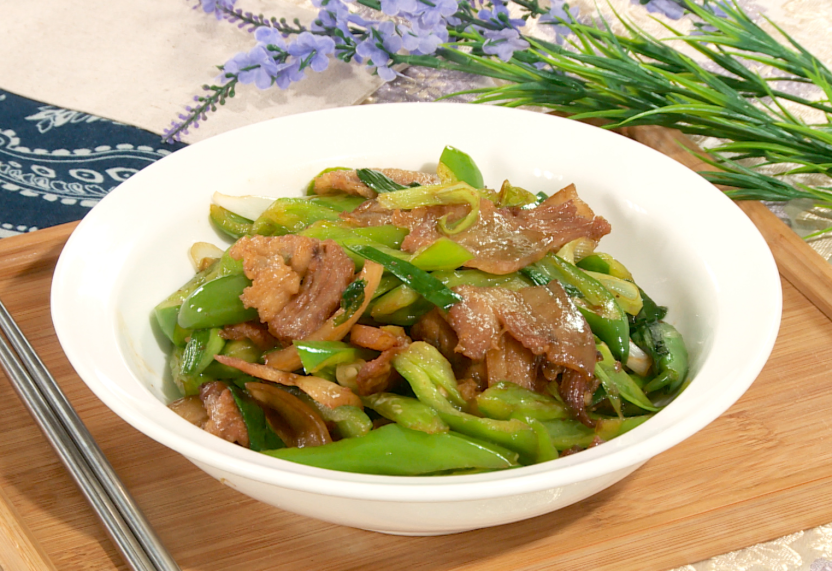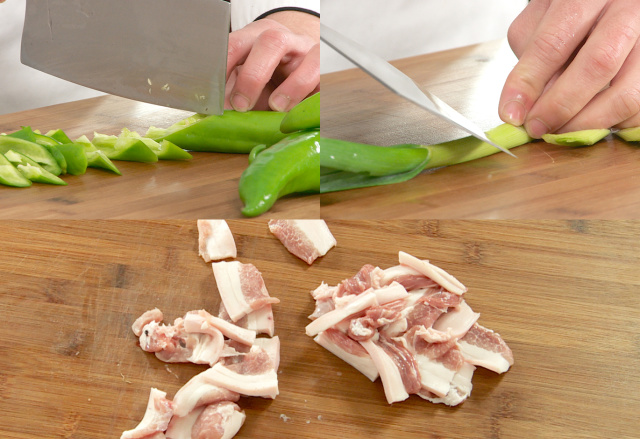Pork Belly recipes(辣椒炒肉)
Stir-Fried Pork with Green Bell Pepper (辣椒炒肉) is a delightful Chinese dish that's rich in flavor and aroma. With tender pork belly and crispy green bell peppers stir-fried together, the dish features a perfect blend of savory and peppery notes. Dark soy sauce adds color and depth, while light soy sauce balances the flavor, making this a simple yet delicious dish that brings authentic Chinese taste to your table.


 26 Comments
26 Comments
For beginners, making this dish is quite manageable if you follow these key tips:
1.Ingredient Sourcing and Substitutions:
Pork Belly: Available at Asian grocery stores, or you can use other fatty pork cuts like pork shoulder or pork belly if you can't find it.
Green Bell Pepper: Found in most supermarkets. If not available, you can substitute with other types of sweet peppers, although the taste may vary.
Garlic Leaf: Usually found in Asian markets. If not available, you can use garlic or green onions (scallions) as a substitute.
Dark and Light Soy Sauce: These are commonly sold in Asian grocery stores. If unavailable, regular soy sauce can be used, but the flavor will differ. Dark soy sauce is used for color, while light soy sauce adds flavor.
2.Mastering the Cooking Process:
Oil Temperature: For stir-frying pork, the oil should be heated to about 320-350°F (160-180°C). This ensures the pork cooks quickly and doesn’t become greasy. Too hot, and the pork may burn; too cool, and it will be oily.
Stir-Frying Technique: Continuously stir the ingredients to ensure even cooking and prevent sticking. Using a suitable wok or deep skillet will help achieve uniform heat distribution.
3.Seasoning:
Soy Sauce: Add soy sauce in moderation to avoid making the dish too salty. Start with a small amount, taste, and adjust as needed.
4.Managing Oil:
Removing Excess Oil: Use a spoon to remove excess oil from the pan while cooking the pork. This prevents the dish from becoming too greasy while keeping enough oil to cook the vegetables.
By controlling the oil temperature, ensuring even cooking, and balancing the seasoning, you’ll be able to create a delicious and well-balanced Stir-Fried Pork with Green Bell Pepper effortlessly!
INGREDIENTS
MAIN INGREDIENTS
- 200 grams (7 ounces) pork belly, sliced
ACCESSORIES
- 200 grams (7 ounces) green bell pepper, cut into chunks
- 1 large garlic leaf, cut into segments
SEASONINGS
- Cooking oil (enough to cover the pan bottom by about 1-2 cm)
- 1 tablespoon dark soy sauce
- 1 teaspoon salt
- 1 tablespoon light soy sauce
DIRECTIONS
STEP 1
Prepare the Ingredients:
Green Bell Pepper: Wash thoroughly, remove the stems and seeds. Cut into chunks. Adjust the size of the chunks according to your preference.
Garlic Leaf: Wash thoroughly and cut into segments. If the garlic leaf is long, cut into 2-3 cm (1-inch) segments.
Pork Belly: Slice the pork belly into thin slices, about 0.5 cm (1/4 inch) thick, to ensure even cooking and flavor absorption.

STEP 2
Heat the Pan:
Pour enough cooking oil into a large skillet or deep pan to cover the bottom by about 1-2 cm (1/2-3/4 inch). Heat the oil until it reaches around 70% heat (approximately 320-350°F), indicated by light ripples on the surface of the oil but before it starts smoking.

STEP 3
Cook the Pork Belly:
Add the sliced pork belly to the hot oil. Stir-fry over medium-high heat until the pork slices change color and start to turn golden brown, about 5-7 minutes depending on your heat level.
Then use a spoon to remove excess oil, leaving about 1-2 tablespoons of oil in the pan for cooking the vegetables.

STEP 4
Season the Pork:
Add 1 tablespoon of dark soy sauce to the pan. Quickly stir-fry to ensure it is evenly coated with the soy sauce. Continue to cook until the pork has a deeper color and the soy sauce is fully absorbed. Remove the pork from the pan and set it aside for later use.

STEP 5
Stir-Fry the Vegetables:
In the same pan, with the remaining oil, add the green bell pepper chunks and garlic leaf segments. Stir-fry over medium heat for about 2-3 minutes until the bell pepper starts to soften and the garlic leaf releases its aroma.

STEP 6
Season the Vegetables:
Add 1 teaspoon of salt to the pan and continue to stir-fry, ensuring that the salt is evenly distributed among the vegetables.

STEP 7
Combine and Mix:
Return the cooked pork belly to the pan. Mix well with the bell pepper and garlic leaf, stirring to combine all the ingredients.

STEP 8
Final Seasoning:
Add 1 tablespoon of light soy sauce. Stir well to ensure the pork and vegetables are evenly coated and flavored. Cook for an additional 1-2 minutes, until everything is heated through.

STEP 9
Serve:
Transfer the stir-fried dish to a serving plate. Enjoy immediately, or serve with rice or another main dish.

Recipe analyzer
- Recipes: Pork Belly recipes(辣椒炒肉)
- Main Ingredients:3
- Servings per recipe:1
- Servings size:403 g
-
Energy (calories):1116 kcal
-
Protein:22.68 g
-
Fat:106.42 g
Why gray?

-
Carbohydrates:18.92 g
-
Protein: 8%90 kcal
-
Fat: 86%960 kcal
-
Carbohydrates: 6%68 kcal

The ratio shows whether the proportion of both fatty acids in your diet is optimal. Red color means too much of Omega 6 or too little of Omega 3. The data are rounded off and approximate.











26 REVIEWS